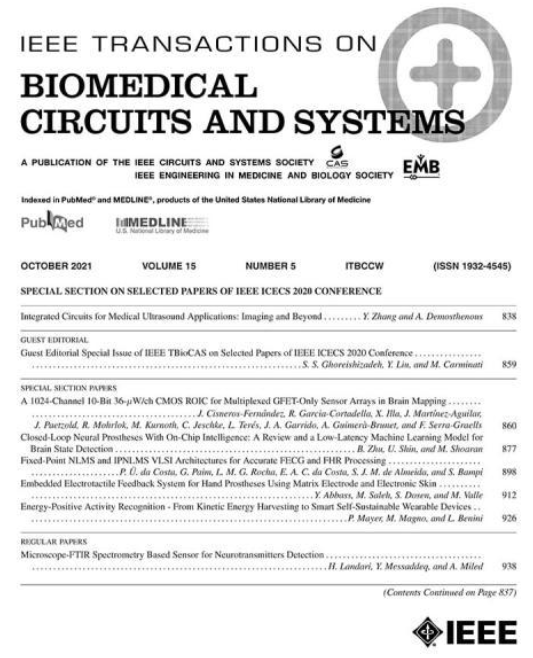用于纳米孔DNA测序的混合半数字跨阻放大器与噪声消除技术
IF 4.9
2区 医学
Q2 ENGINEERING, BIOMEDICAL
IEEE Transactions on Biomedical Circuits and Systems
Pub Date : 2015-11-19
DOI:10.1109/TBCAS.2015.2496232
引用次数: 25
摘要
在过去的二十年中,纳米孔已经成为下一代脱氧核糖核酸(DNA)测序的一种有前途的技术。在这里,我们提出了一种混合半数字跨阻放大器(HSD-TIA),用于检测单链DNA (ssDNA)通过纳米孔移位所引入的微小电流特征,同时使用半数字反馈回路放电基线电流。当检测到阶跃输入时,放大器通过自适应调整直流补偿电流来实现快速沉降。噪声消除技术降低了由寄生输入电容引起的总输入参考电流噪声。测量结果表明,该放大器具有31.6 M Ω中频增益,950 kHz带宽和8.5 fA/√Hz输入参考电流噪声,由于噪声消除技术,噪声降低了2倍。通过观察脂质双分子层中蛋白质纳米孔的插入,证明了沉淀反应。利用纳米孔,HSD-TIA能够测量ssDNA易位事件。本文章由计算机程序翻译,如有差异,请以英文原文为准。
A Hybrid Semi-Digital Transimpedance Amplifier With Noise Cancellation Technique for Nanopore-Based DNA Sequencing
Over the past two decades, nanopores have been a promising technology for next generation deoxyribonucleic acid (DNA) sequencing. Here, we present a hybrid semi-digital transimpedance amplifier (HSD-TIA) to sense the minute current signatures introduced by single-stranded DNA (ssDNA) translocating through a nanopore, while discharging the baseline current using a semi-digital feedback loop. The amplifier achieves fast settling by adaptively tuning a DC compensation current when a step input is detected. A noise cancellation technique reduces the total input-referred current noise caused by the parasitic input capacitance. Measurement results show the performance of the amplifier with 31.6 M Ω mid-band gain, 950 kHz bandwidth, and 8.5 fA/ √Hz input-referred current noise, a 2× noise reduction due to the noise cancellation technique. The settling response is demonstrated by observing the insertion of a protein nanopore in a lipid bilayer. Using the nanopore, the HSD-TIA was able to measure ssDNA translocation events.
求助全文
通过发布文献求助,成功后即可免费获取论文全文。
去求助
来源期刊

IEEE Transactions on Biomedical Circuits and Systems
工程技术-工程:电子与电气
CiteScore
10.00
自引率
13.70%
发文量
174
审稿时长
3 months
期刊介绍:
The IEEE Transactions on Biomedical Circuits and Systems addresses areas at the crossroads of Circuits and Systems and Life Sciences. The main emphasis is on microelectronic issues in a wide range of applications found in life sciences, physical sciences and engineering. The primary goal of the journal is to bridge the unique scientific and technical activities of the Circuits and Systems Society to a wide variety of related areas such as: • Bioelectronics • Implantable and wearable electronics like cochlear and retinal prosthesis, motor control, etc. • Biotechnology sensor circuits, integrated systems, and networks • Micropower imaging technology • BioMEMS • Lab-on-chip Bio-nanotechnology • Organic Semiconductors • Biomedical Engineering • Genomics and Proteomics • Neuromorphic Engineering • Smart sensors • Low power micro- and nanoelectronics • Mixed-mode system-on-chip • Wireless technology • Gene circuits and molecular circuits • System biology • Brain science and engineering: such as neuro-informatics, neural prosthesis, cognitive engineering, brain computer interface • Healthcare: information technology for biomedical, epidemiology, and other related life science applications. General, theoretical, and application-oriented papers in the abovementioned technical areas with a Circuits and Systems perspective are encouraged to publish in TBioCAS. Of special interest are biomedical-oriented papers with a Circuits and Systems angle.
 求助内容:
求助内容: 应助结果提醒方式:
应助结果提醒方式:


